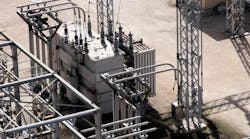The U.S. Department of Energy (DOE) has finalized congressionally mandated energy efficiency standards for distribution transformers to increase the resiliency and efficiency of America’s power grid, support good-paying, high-quality manufacturing jobs, and accelerate the deployment of affordable, reliable, and clean electricity.
The updated standards, which includes a longer compliance timeline of five years, will save American utilities and commercial and industrial entities $824 million per year in electricity costs, and result in more demand for core materials like grain-oriented electrical steel (GOES).
“Today’s actions reflect DOE’s deep commitment to developing forward-looking solutions that align with President Biden’s industrial policy goals, including creating good-paying jobs, strengthening domestic manufacturing, and helping American workers capture the economic benefits of our clean energy economy," said U.S. Secretary of Energy Jennifer M. Granholm. “Ultimately, it will be a piece of the solution, rather than a barrier, to help resolve the ongoing distribution transformer shortage and keep America’s businesses and workers competitive."
The updated final standards are expected to be met with GOES, the majority of which will be manufactured in the U.S., and a small segment of the market will be met with amorphous alloy, also expected to be manufactured in the U.S. Improvements to efficiency of distribution transformers will reduce wasted energy on the power grid and provide significant energy savings to the nation.
The new standards are expected to save Americans over $14 billion in energy costs, while also reducing nearly 85 million metric tons of CO2 emissions, equivalent to the combined annual emissions of nearly 11 million homes, over 30 years.
The energy savings over 30 years of shipments is 4.6 quadrillion British thermal units, which represents a savings of 10% relative to the energy use of products currently on the market.
These standards are expected to protect existing domestic supply of core materials used in distribution transformers, increasing resiliency in the distribution transformer supply chain, while preserving steel union manufacturing jobs in Pennsylvania and Ohio. The GOES production at the locations will also benefit from DOE’s $75 million grant, as part of President Biden’s Investing in America agenda, for furnace upgrades to cut carbon emissions, which are expected to make U.S. domestic GOES amongst the lowest emission GOES in the world.
The initial proposal represented about a 95% market shift to amorphous alloy, while the final rule represents about 75% of the market to be able to achieve the standards with GOES.
The final rule extended the compliance timeline to five years from three years.
The changes took into account stakeholder concerns about the feasibility challenges presented by the proposed efficiency levels, including the magnitude of anticipated workforce reskilling. The final rule gives manufacturers more flexibility to meet modest efficiency increases as distribution manufacturers prepare existing and develop new manufacturing lines to increase the nation’s total distribution transformer manufacturing capacity.
A recent study by the National Renewable Energy Laboratory (NREL) estimated a tripling of distribution transformer installations by 2050. These adopted standards balance the supply chain concerns of installation increases, while making significant strides in efficiency gains of these units.
The efficiency standards, which include liquid-immersed, low-voltage dry-type, and medium-voltage dry-type equipment, includes feedback from manufacturers, the manufacturing trade association, union workers, energy and environmental advocacy groups, state officials, and utility organizations and companies.
DOE is leading government and private sector convenings to address near-term supply chain challenges for distribution transformers and other key components in the electric grid, while updating the energy efficiency standards as directed by Congress.
This includes moving potential programmatic and resources across government, including not only existing R&D programs, but programs within the Bipartisan Infrastructure Law to improve supply chain and enhance grid resilience.
DOE follows Congressional direction for energy savings to maintain reliability and performance across household appliances and commercial and industrial equipment. The actions are part of a suite of energy efficiency standards advanced by the Biden-Harris Administration this term that DOE projects will together provide about $1 trillion in consumer savings over 30 years and save the average family at least $100 a year through lower utility bills.
According to DOE estimates, these standards will cumulatively reduce greenhouse gas emissions by 2.5 billion metric tons or more, an amount roughly equivalent to the emissions of 18 million gas-powered cars, 22 coal-fired power plants, or 10.5 million homes over 30 years, once finalized.
These actions support the path of consumer savings included in President Biden’s Investing in America agenda and highlight the Biden-Harris Administration’s aim to deal with climate crisis with reduced costs for American families and businesses.
Consumers can use DOE’s Energy Savings Hub, an online resource to access the cost-saving benefits of President Biden’s Investing in America agenda. The website outlines clean energy tax credits and forthcoming rebates, helping people take control of their energy costs and have cleaner and more efficient options as a consumer.


